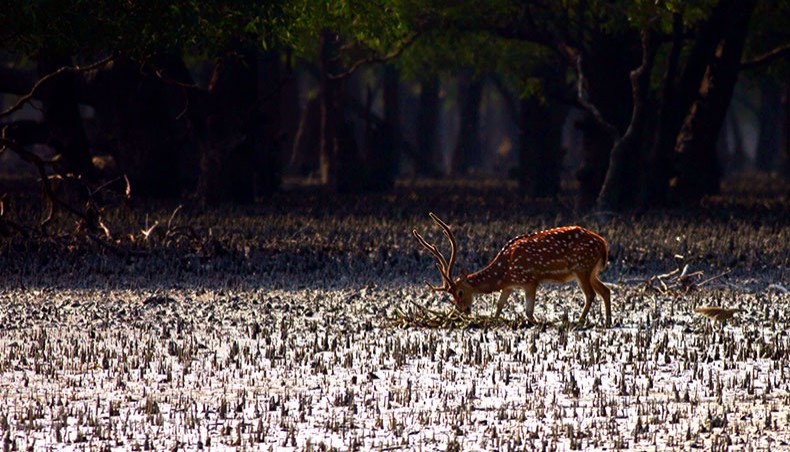Sunderbans’ ecology, status under threat
International Union for Conservation of Nature known as IUCN, the official advisor on natural world heritage to UNESCO, has recommended for inclusion of Sunderbans on UNESCO’s ‘world heritage in danger’ list.
The recommendation was made due to ongoing construction works of the coal-based power plants and over a hundred industrial projects to be constructed near the largest mangrove forest in the world.
UNESCO on June 7 published the IUCN’s recommendations on its website for degrading the status of Sunderbans and two other sites from the ‘world heritage’ to the ‘world heritage in danger’ list.
The decision on the fate of Bangladesh’s only mangrove forest, Mexico’s Islands and protected areas of the Gulf of California as well as the Ohrid region in North Macedonia would be made in the 43rd session of the world heritage committee meeting scheduled to be held in Azerbaijan’s capital from June 30 to July 10.
‘At present, 16 natural world heritage sites are listed as “in danger”. The list is prepared to let the world know about the possible destruction of the heritage sites in natural disaster or due to the negligence of the country where it is located,’ according to the UNESCO website.
For this year’s world heritage committee meeting, IUCN has provided recommendations for about 60 natural world heritage sites facing threats and has evaluated 10 sites that are to be nominated as potential new sites.
Bangladesh National Commission for UNESCO and concerned government officials said that they were not aware of the move while the greens termed it as the result of government’s negligence and stubbornness for initiating ‘development projects’ at the cost of environment and the integrity of one of the unique natural forests of the world.
In 1997, Sunderbans, home to the royal Bengal tiger, was enlisted as the natural heritage of the world for its exceptional biodiversity in both terrestrial and marine environments.
According to the IUCN recommendation for Sunderbans, the forest is in danger due to severe threats from the coal-fired power plants and numerous industrial activities in close proximity.
Following a joint IUCN-UNESCO mission in 2016, IUCN advised the world heritage committee of UNESCO to call for the cancellation and relocation of Rampal power plant, a mega project planned 65 km from the site.
Despite this, its construction has continued without any assessment of its impact on Sundarbans’ world heritage values, the document said.
Instead, two additional coal-fired power plants were being constructed on the Payra River, which flows into the bay and Sundarbans, according to the document.
It further said that over 150 industrial projects were also active upstream of the site, and their associated shipping and dredging activities further threatened the hydrological and ecological dynamics of the region.
The hydrological systems, which drive this dynamics, are very large in scale and vulnerable to upstream impacts.
In the 41st session of the world heritage committee meeting held in 2017 in Poland, UNESCO welcomed the government’s decision not to approve the Orion power plant and Phase II of the Rampal power plant, according to the minutes of the session.
In the same session, UNESCO’s committee welcomed the country’s decision to carry out a strategic environmental assessment for the south-west region of Bangladesh, including the power plants.
Additionally, it requested Bangladesh to ensure that any large-scale industrial and/or infrastructure developments should not be allowed to proceed before the assessment was completed and to submit a copy of the assessment to the world heritage centre for review by IUCN.
The committee welcomed the government’s pledge to frame a draft national oil spill and chemical contingency plan and also requested Bangladesh to put in place a management system for shipping to minimise negative impacts on the forest, including from associated activities.
UNESCO committee also welcomed the transboundary cooperation between Bangladesh and India on the world heritage properties, ‘Sundarban’ and ‘Sundarbans National Park’ (India). It further welcomed the efforts made by both countries to enhance collaboration and urged Bangladesh to fully implement the recommendations made by the 2016 mission in relation to ensuring adequate freshwater inflow to the forest.
UNESCO also requested Bangladesh to submit to the world heritage centre by December 1, an updated report on the state of conservation of the forest and the implementation of the above which would be examined by the world heritage committee at its 43rd session in 2019.
‘The government did not keep any of its pledges to UNESCO even though we repeatedly advocated for it,’ national committee for protection of Sunderbans convenor Sultana Kamal told New Age.
‘The government did not even care that the 13 reports we submitted to them mentioning possible threats posed on the environment by power plants, “red category” industrial parks and economic zones,’ she said.
Transparency International Bangladesh executive director Iftekharuzzan said that the government thought that using Indian influence on UNESCO it would be able to continue its destructive projects near Sunderbans.
‘India has vested interest in the ongoing development activities in the area. But it was unlikely that it would be able to save Sunderbans from getting enlisted as world heritage in danger as the global community knows the facts very well,’ he said.
Bangladesh National Commission for UNESCO deputy secretary general Md Monjur Hossain said he was not aware of UNESCO’s move for degrading Sunderbans’ status on their heritage list.
‘We are yet to receive any message from UNESCO,’ he said.
Chief forest conservator Mohammad Shafiul Alam Chowdhury said that the power and energy ministry was supposed to present the structural environment assessment report to UNESCO.
State minister for power, energy and mineral resources Nasrul Hamid said, ‘The power plants were developed after taking clearance from the environment ministry. It is their duty to know whether the plants would be harmful for the forest or not.’
Environment minister Md Shahab Uddin said he would look into the matter.
News Courtesy: www.newagebd.net











